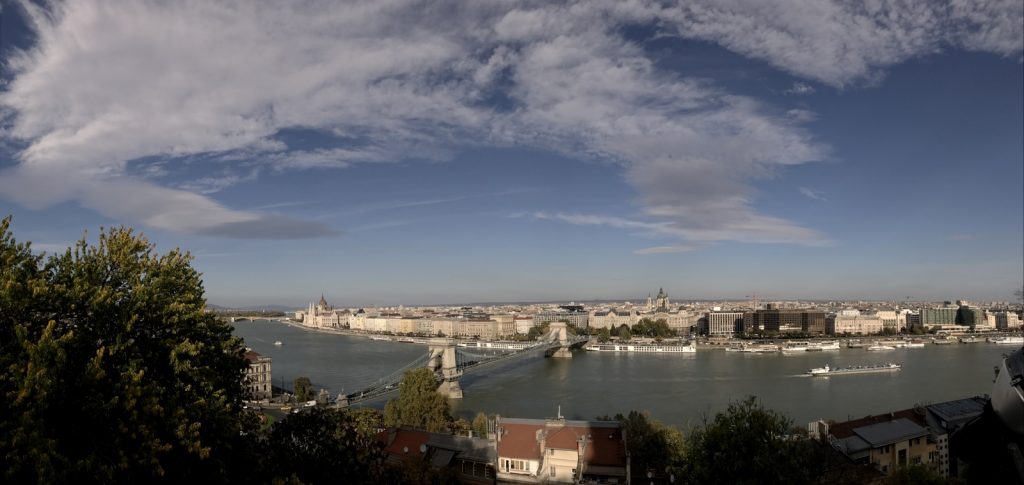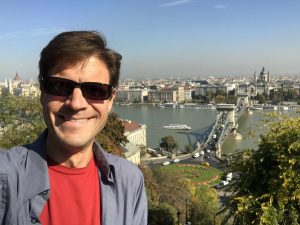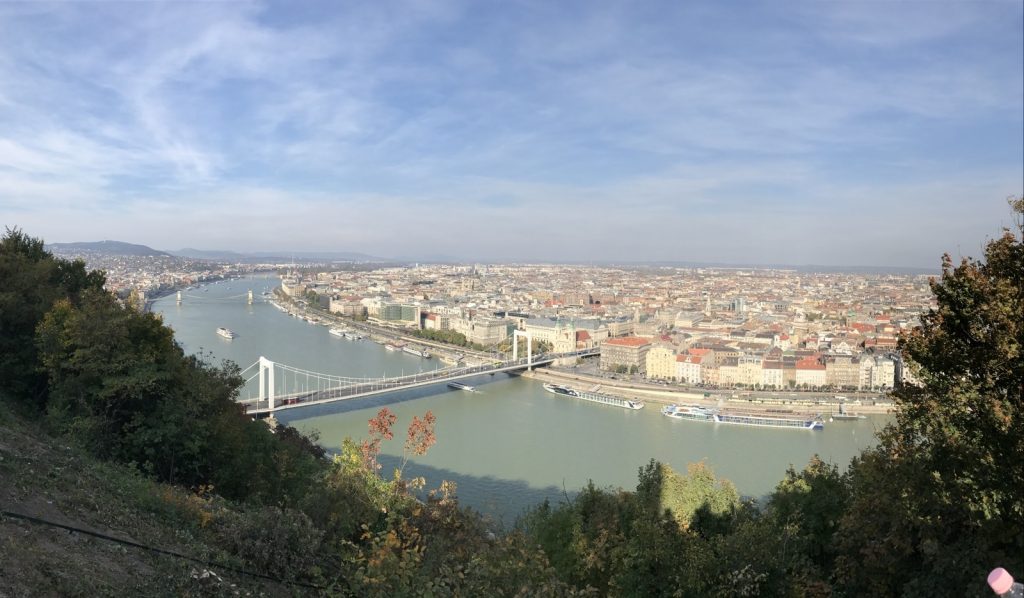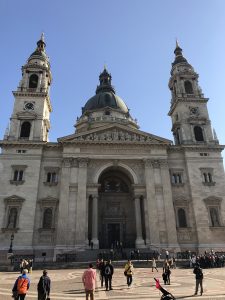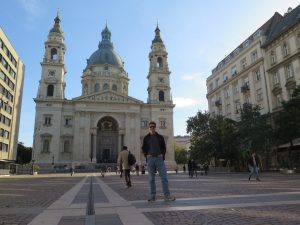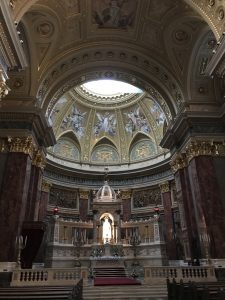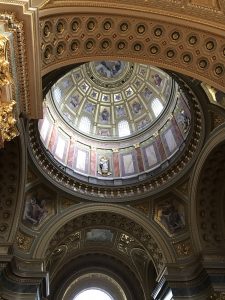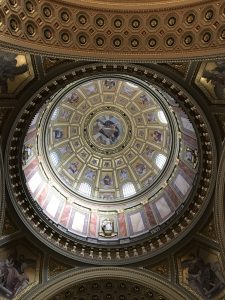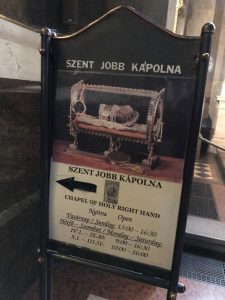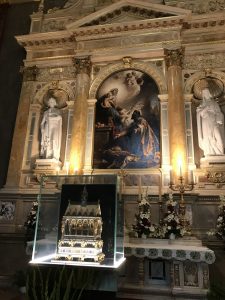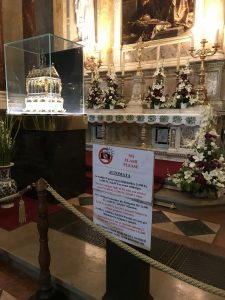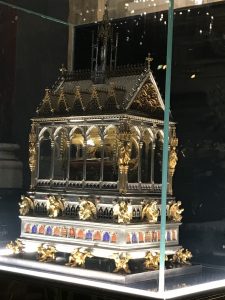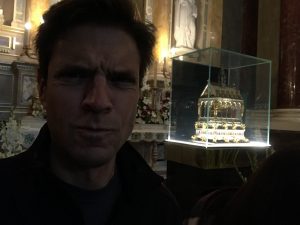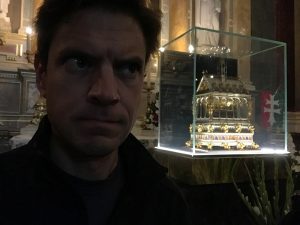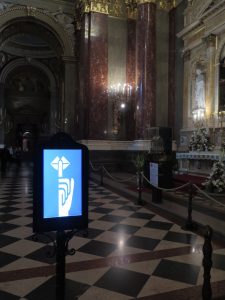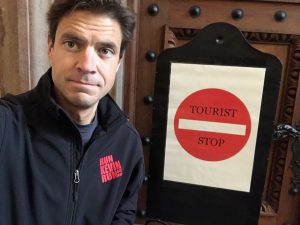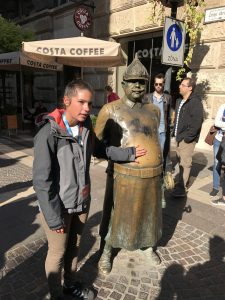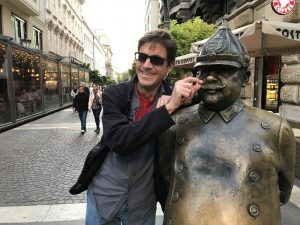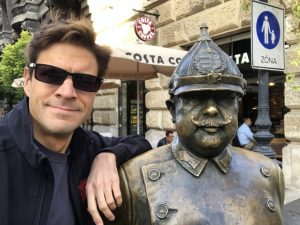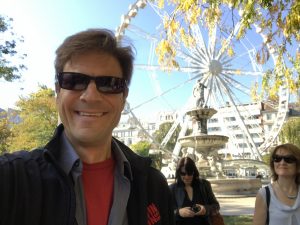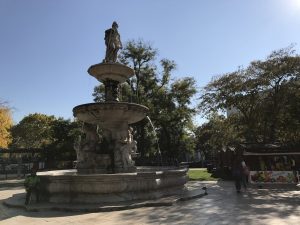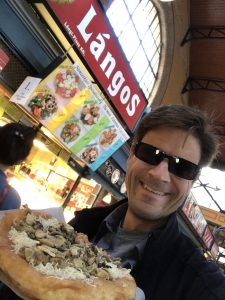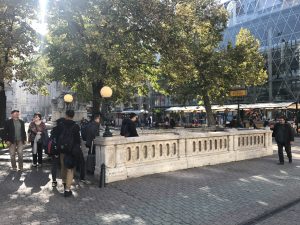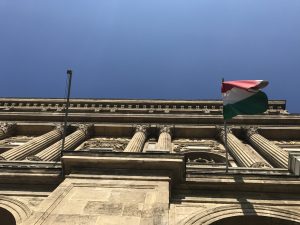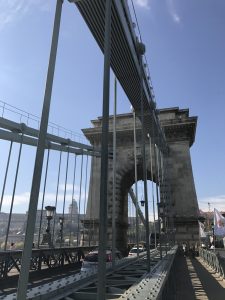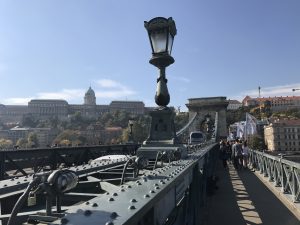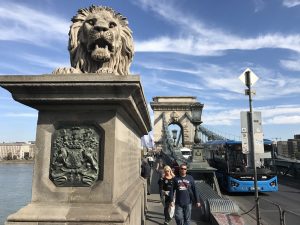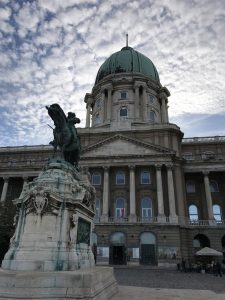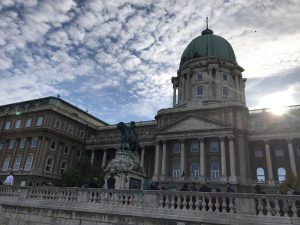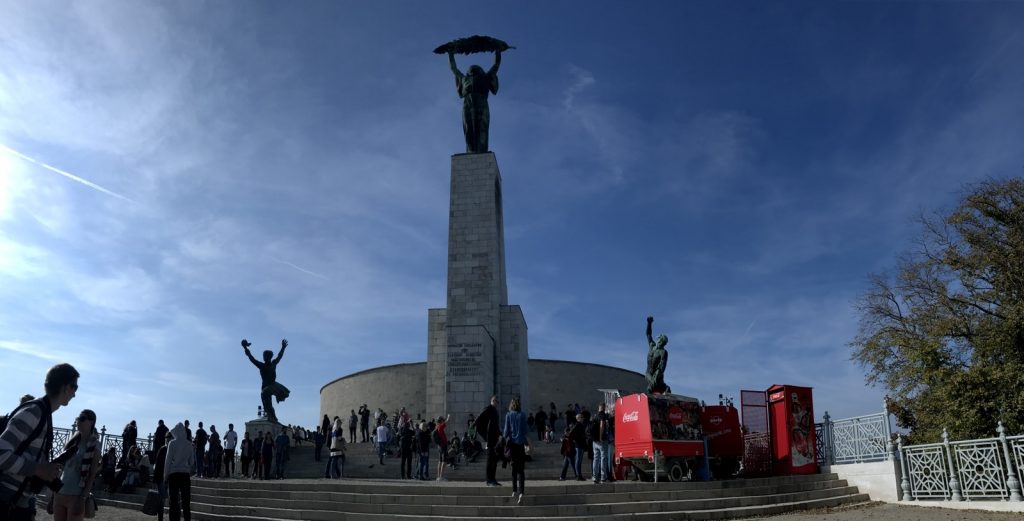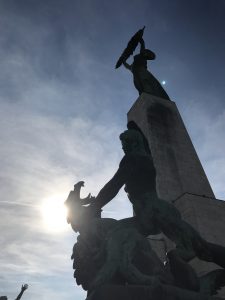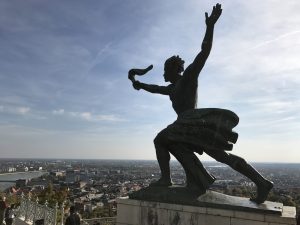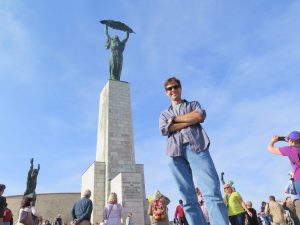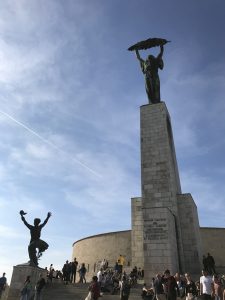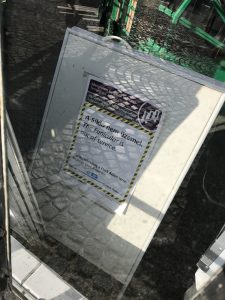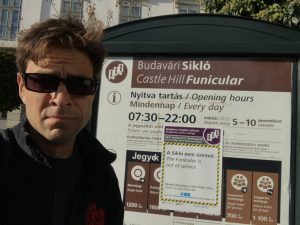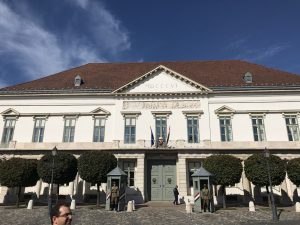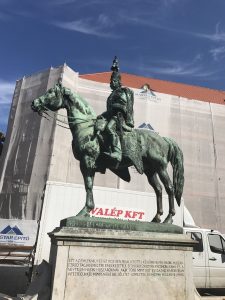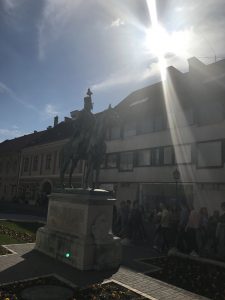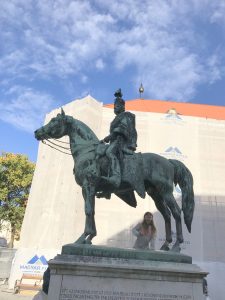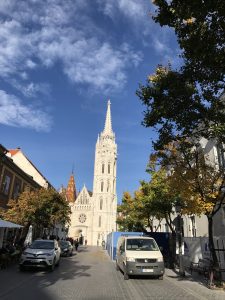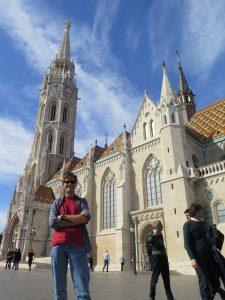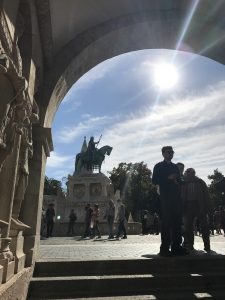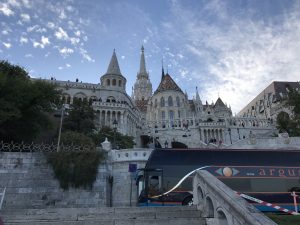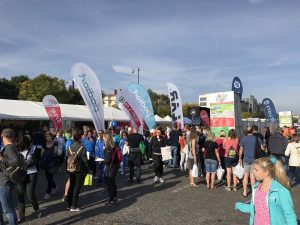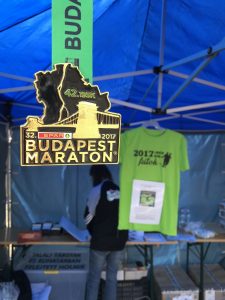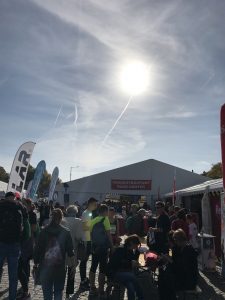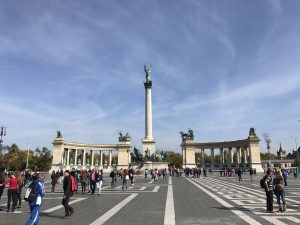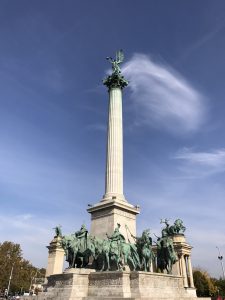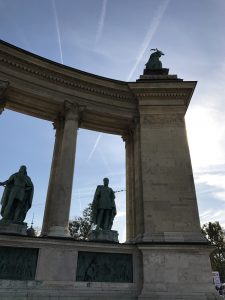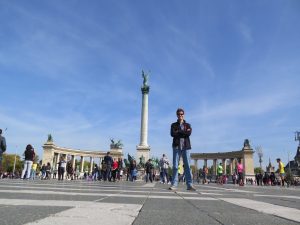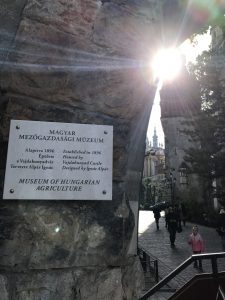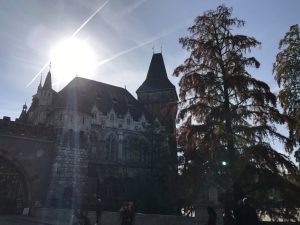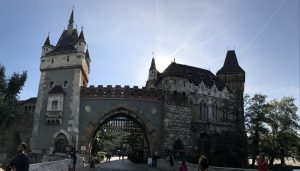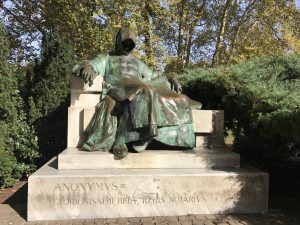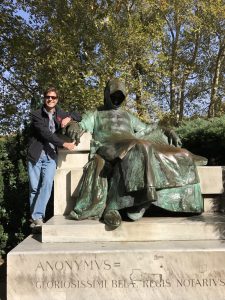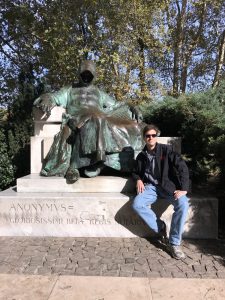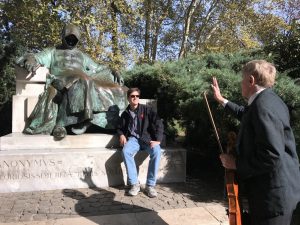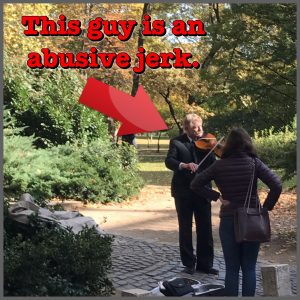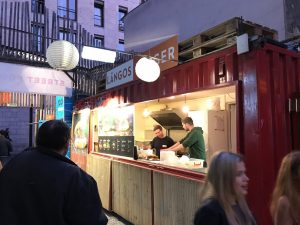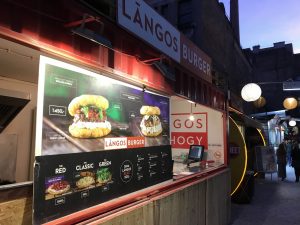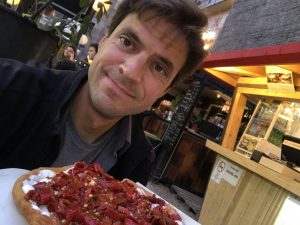After 150 years of occupation by the Ottomans, after a series of events long after that, and after a bloody decisive battle, two cities divided by the Danube River, Pest on the East bank and Buda on the West, united in 1873. This new supercity was called Budapest.
What follows here is a mélange. It incorporates photos from several days wandering, stories gleaned from free tours (or more accurately, pay as you like), and from a mix of flipping through the Hungarian language guidebook my AirBNB host left me and my own google searches of the internet (which very often prompted Hungarian results that I would filter into English only or English translation). You’ll notice my shirt color sometimes changes, or my hair goes from having an awful day to at best a middlingly bad one. The script continuity team dropped the ball, what can I say?
My general impressions of the city are frustrations. Whether that’s due to the amount of time I’ve been living out of my duffle bag or the people proper I cannot say with any certainty. But the noise has gotten to me and that could be a result of a little from column A and a little from column B above. Shouting at friends/colleagues/associates over cigarettes and beer, bicycles’ bells to tell me to get out of the way, honking horns from gridlocked cars, police sirens… it all has me flinching. Walking the city, I’m leery of jaywalking as Regie, my free tour guide, warned the police are inconsistently strict about it here in Budapest, writing tickets only occasionally but when they do the fines are super steep. The crosswalk lights are seemingly designed to make it so you might make it across but if you follow the flickering and flashing greens leading to ominous reds, you’re really only supposed to make it to the halfway traffic island on any given light… no matter how few lanes the road may be. It’s maddening and infuriating and all the more difficult as the shouting, bike bells, honking, sirens reverberate round.
And so as I begin collating the facts, figures, legends, and impressions of Budapest, I’m also prepping for tomorrow’s marathon which promises a running sightseeing tour of this city, the capital of Hungary. I’m very stiff and sore, partly with age and partly with this crappy apartment I find myself in. The biggest mistake I’ve made on this trip, and there have been many doozies to be sure, might be that I didn’t grab my stuff, forfeit the money I paid AirBNB, and go find some place else to stay. And this coming from a guy who stays at murder hotels. I’m not sure if that will make it into my review of the stay but it should.
Bottom line though – I’m worried about the run tomorrow on a variety of fronts. I’m pretty sure that sinus infection has morphed into an ear infection. I’m pretty sure these aches and pains of age and sleepless nights in an uncomfortable bed aren’t suddenly going to resolve themselves. I’m pretty sure Pest is pretty flat land but Buda is known for its hills and thus I may be looking at a bit more up and down action than I’ve had in the last few races.
And I’m just feeling… melancholic? Morose? Depressed? Again, the causes and reasons for these feelings are as numerous and mixed as the worries from above.
But enough of that palaver. I should cut all of that as who cares? Maybe it’s because these scribbled 1s and 0s digital notes in a virtual bottle tossed into the sea of the internet are read by few if any and such ramblings are confined as it is. But I suppose I’m including such thoughts as a personal record for me and as signpost that maybe it’s time to cut back or really to abandon this whole thing.
Enough, enough. On with the picture show.
***
Let’s begin as my walking tour on October 12, 2017, did. This is St. Stephen’s Basilica. Stephen was the first king of Hungary, the one who united the pagan tribes for Christianity in 896 and founded what would eventually be Budapest. That year and its numbers have great significance to the citizens of Hungary. As a result, there’s an age old law that no building in the city can be higher than 96 meters. St Stephen’s dome tops out at 96, making it the largest Roman Catholic Church in the city. The Parliament building is also 96 meters tall, representing the balance and equality of church and state. But I’ve posted Parliament shots already so here’s St. Stephen’s Basilica:
The church began construction in 1850 and it took 55 years to finish. The dome was a problem and has collapsed twice – once during construction as the architect was either a bit of a boozer or ill and made some bad calculations. The second time was in World War II, when like a lot of structures in town, the dome was destroyed.
Inside, one can see a famed relic – the right hand of St. Stephen. When he was canonized, the Roman Catholic Church dug him up and while most was just bones, his right hand had been preserved and mummified so now it’s on display as a religious artifact. It’s creepy and I don’t understand why we do such things… but I went and took a photo.
I thought this sign was a weird right hand pointing out the direction I needed to follow to find, well, the right hand. Turns out it’s a shushing “please be quiet in the church” image.
While the “tourist stop” signs are actually warnings to “do not enter” they might as well have been notices of tourist traps.
***
From there we walked the road to one of the most famous of modern Hungarians – Uncle Charlie. Charlie was a rotund, jolly police officer, friend to young and old, and lover to many a lady. The lengend goes that his statue is said to be good luck if you rub his belly… and it’s doubly favorable if you twirl his moustache, his patented move to woo the ladies. But be careful – stand on his right side if you’re a woman of good moral fiber. If you stand on his left, it means you’re a lady of the night.
FYI – Uncle Charlie is actually a statue from 2008, the figure modeled on the artist’s grandfather. To be fair, his grandpapa was a policeman but it’s unclear if he was the Don Juan of Justice or not.
***
Elizabeth Square is named for Queen Elizabeth. Not QE of England, Queen Elizabeth of Astro-Hungary, a nation formed in the 1840s during the one time in Hungarian history that they didn’t lose a revolution or war; in this case it was more of a draw, enabling them to get parity with Austria. As it was a double-monarchy, Queen Elizabeth split her time within the borders of two countries. Her nickname was Cici, and apparently she was a big fan of the Budapest, and of this park area in particular. Was it because it was where she had her secret rendez vous with her lover, the Prime Minister? Probably, as who historically isn’t sleeping with whom on this free tour?
In any case, Elizabeth Square is also home to the Budapest Eye. As my guide said, “I’m not going to lie, we just copied the London Eye… but it’s small and so no one cared.” Fair enough.
There’s also a big fountain to Danubius, the god of the Danube. The sprites under him represent the three longest rivers in the country thereafter.
***
Here’s a quick note on the Hungarian language. I previously mentioned this but the fastest way to learn what linguists have called one of the top three toughest languages to learn in the world (Slovatkian is apparently ALWAYS the gold standard number 1 toughest but Hungarian vacillates between silver and bronze). You take three shots of unicum. But I actually think our guide said we should drink pálinka which she said was to Hungary what vodka is to Russia. Pálinka is apparently a flavored fruit brandy with all kinds of variations. Point is after three shots of Hungaraian liquor, you’ll swear you speak the language like a local.
Oh, and there’s 44 letters in the Hungarian alphabet. The longest Hungarian word is Megszentségteleníthetetlenségeskedéseitekért which is 44 letters long (I don’t know if it has all the letters of the alphabet or not) but it means “for your [plural] continued behaviour as if you could not be desecrated.” I don’t even know how to parse that definition let alone how to say the word.
Hell, I can’t even say humuhumunukunukuapuaa, the Hawaiian fish with the 21 letter long name, which is pronounced as “who moo who moo new coo new coo ah poo ah ah.”
There’s also apparently a Hungarian word with 28 letters that means “you should put less cabbage in than you have to.” I can’t find that on google though.
Anyway, here’s some handy phrases Regi our guide on the walking tour gave us:
- “Hello” is apparently pronounced “see ya” in Hungarian.
- “Goodbye “is apparently pronounced “hello” in Hungarian.
- When you say “Goodbye” on the phone , it usually sounds like, “ok ok, hello pussy.” Pussy apparently is the Hungarian work for “kiss” or “kisses.” Gossip Girl would approve. X-O-X-O.
- If you’re in a bar, “Cheers” sounds something like “eggy shake a drive.” I’m not sure if that’s like “Don’t Touch My Moustache” for “you’re welcome” in Japanese or if she’s pulling our legs or what.
- Note: if you find yourself in a bar, just say to a local “Six to three.” This is apparently a famed football score wherein Hungary won an important rivalry game in the 1950s… and to this day they’re still proud of it and if you reference it you’ll seem like a good eggy to shake a drive with.
***
I’ve previously written about my disappointment with various Hungarian dishes and drinks. But I did finally today have what Regie called “communist pizza.” Its real name is lángos, a deep fried dough that you can put various toppings on. The classic is just cheese on it but I went with cheese and mushrooms.
***
The oldest underground metro in CONTINENTAL Europe is in Budapest. Regie kept emphasizing the “CONTINENTAL Europe” designation on a few things; she said this is a sure sign that there’s an older one in the United Kingdom but since they’re not on the continent, well…
The metro was built in 1896 to help with congestion brought about for the Budapest exhibition honoring the 1000th Anniversary of the founding of the city.
***
Back on the Pest side, this is the Hungarian Academy of Sciences.
Some things invented/discovered by Hungarians according to my tour guide:
- The Rubik’s Cube was invented by a Hungarian!
- The Ballpoint pin
- The X ray
- Color tv
- Microsoft Word and Excel
- Atomic bomb work
- And a Hungarian was awarded the Nobel Prize for “discovering” Vitamin C. He was the first to extract it and he got the vitamin from paprika.
***
This is the famed Chain Bridge.
The story goes that In the 19th Century there were no permanent bridges in Budapest, only temporary ones. A rich Pest man got news he father was sick in Austria and dying. It took three weeks for the ice to break and for the man to get across to Buda to then get to Vienna. By that point, his father was dead. He promised to build a permanent bridge to honor his father and thus the Chain Bridge was envisioned and constructed.
There are four lions on the bridge. Guide books will say the architect was so proud of his work on these lions that if anyone found a mistake, he’d immediately throw himself off the bridge and commit suicide. A boy walking with his mother one day said, “But the lions don’t have any tongues.” And thus the man jumped off and killed himself. This is just an urban legend for a variety of reasons. The lions DO have tongues they’re just hard to see from below – you need to climb up and see them. And the architect didn’t commit suicide. But it’s one of the most famous stories told in Budapest. It just happens to be a lie.
***
Heading over the Chain Bridge, you cross the Danube from Pest (pronounced, please, “PestH” not “Pest.” “People who says Pest are pests….”)
The Buda Castle which is on Castle Mountain is neither on a mountain nor a Castle. It was destroyed in World War II and rebuilt as a historical museum and houses the national library amongst other things. It’s a Castle built on lies.
***
The Liberty Statue, which I walked up to on the day before the Marathon (I’ve never been a smart man), sits atop Gellért Hill, which rises 235 meters above the Danube.
The Soviets erected it as a present to the people when they liberated the country from the Nazis. According to Wikipedia, the original plaque said:
A FELSZABADÍTÓ
SZOVJET HŐSÖK
EMLÉKÉRE
A HÁLÁS MAGYAR NÉP
1945which can be translated to read, “To the memory of the liberating Soviet heroes [erected by] the grateful Hungarian people [in] 1945”.
Over the following years, public sentiment toward the Soviets decreased to the point of revolution, which was attempted and temporarily succeeded in 1956 and subsequently damaged some portions of the monument. After the 1989 transition from communist rule to democracy, the inscription was modified to read:
MINDAZOK EMLÉKÉRE
AKIK
ÉLETÜKET ÁLDOZTÁK
MAGYARORSZÁG
FÜGGETLENSÉGÉÉRT,
SZABADSÁGÁÉRT
ÉS BOLDOGULÁSÁÉRTTranslated from Hungarian: “To the memory of those all who sacrificed their lives for the independence, freedom, and prosperity of Hungary”
***
A few notes on the differences between Buda and Pest. Pest is flat while Buda is hilly. Buda had been a historical royal port for centuries and it’s considered the more desirable and therefore pricier property market. The Buda side is pretty snobby about it. They can often be heard saying things like, “The only good thing in Pest is view of Buda hills.” Sigh.
There’s a fault line running under the Danube so there are a lot of thermal hot springs. As a result, there are a number of bath houses in the city. I maybe should’ve tried going to one as they’re open to the public (for a fee) but it just didn’t seem like my thing this trip. I enjoyed the Blue Lagoon in Iceland so I’m sure it would’ve been fine but… I don’t know. I skipped it.
***
Having climbed up Castle Mountain, we took in the view. The famed Budapest Funicular was closed for repairs but Regie said she thought it was overpriced for the trip anyway so we lucked out. I skipped the one in Zagreb so I probably would’ve skipped this one too. One of these days I need to look at doing the one in Los Angeles though.
In 1806, this building was built for Count Vincor Sandor and thus is now known as Sándor Palace. I was bummed to google this later as I thought Regie said “Shandor palace!” and I thought it was based on the name of Ivo Shandor, the architect in Ghostbusters (the real one, the one from 1984). Today it’s the official residence for the Hungarian President. But like that office itself (the real power is with the Prime Minister), the palace is more ceremonial than anything else. There’s a changing of the guard every hour but it’s mainly for the tourists.
***
The most popular statue on the Buda side is of András Hadik. And in actuality the fame comes from his horse’s, um, testicles. The legend says that in Communist era Hungary, when rock music was banned, kids would look to screw up their courage to try and evade the Secret Police to get to the club and would therefore rub this horse’s, well, there’s no other way to say this, they’d rub the horse’s balls. Apparently it comes from the literal translation of “clubber” in Hungarian which is something akin to “balls of horse.” True, not true? Who knows. But those testicles are rubbed shiny bright that’s for sure.
End of semester exams coming up? Students make a pilgrimage. Anyone who needs a bit of luck in fact. Supposedly it’s illegal to climb up and touch the balls but here’s a shot of a father hoisting up his daughter so his wife could snap a photo.
***
Just around the corner is the Matthias Church.
Originally named the Church of our Lady when it was built in the 13th Century, it was renamed after King Matthias made Budapest a renaissance center in the 15th century. Matthias was a big fan of the place – had his coronation and BOTH of his weddings here.
In 1526, the Ottomans occupied Budapest and tore off any Christianity symbols to rebrand the place as a mosque. Upon their exit 150 years later, the place was retrofitted back into a catholic church. The colorful roof is due to the porcelain tile work of the Hungarian artisans.
In 1896, to commemorate the 1000th Anniversary of Hungary’s founding, the area was commissioned to be renovated once more. The Fisherman’s Bastion was added, a series of watch towers where in medieval times lookouts would watch for fishing boats to come in. There’s some great views from here.
***
One of the things I had listed on my to see list was the Heroes’ Gate. It turns out it was right nest to the marathon expo and start line so I got to revisit the place when it was a bit more lively. Nestle was out in full force was a cadre of foam mascots. But the costumes felt like a feverish addict’s version of the characters. If heroes’ gate was just ahead, this was heroin’s gate.
The Heroes’ Gate was all well and good – but like Piccadilly Circus being a lame “circus” with nary an elephant or ring master in sight, the Heroes’ Gate is really just a big square with imposing phalanxes of statues of, well, Hungarian heroes.
Just through the gate one could find the grounds to the Hungarian agricultural museum.
It’s a charmingly medieval structure… and is also home to the famed statute of Anonymous. Legend says if you hold onto his pencil you’ll be made a great writer. Given this blog post either it’s another unlikely urban superstition or maybe it takes awhile to have an effect.
This is also where I met another terrible citizen ambassador for Hungary. This guy was husking with his violin right beside Anonymous. Twice he asked me where I was from and I told him as I was waiting to take a photo. He’d ask other people and play a quick snippet of a local tune soliciting tips and offering to take a funny photo with you. When I got a chance to snap a photo with Anonymous. A nice guy offered to take it for me. As I’m sitting down, this fiddler jumps in front of the camera and asks me where I’m from. I tell him I’m just trying to take a photo– and then he starts cussing me out, saying how awful the English are, rants and raves in Hungarian,’says I haven o respect. He heads off in a huff, still cursing and gesticulating with his bow threateningly. The nice guy snaps my photo, I thank him and then decide screw it. I say to the angry violinist, “now what did you want to ask me?” He again curses me, but this time sheepishly and quietly. I tell him he should be ashamed of the way he behaved but I hope he had a better day hereafter. It was an awful experience but only the first of the day’s dealings with indignant Hungarians.
For dinner I was debating what to do and ultimately settled on a food truck alley that offered an assortment of options. I picked another lanos, this time with roasted red peppers. The guy working the truck ignored me for two minutes while he continued grating cheese. Then after I ordered he scolded me for standing too close to the truck and told me to come back I five minutes. When I did, he demanded proof I paid even though he was the one who took my money.
I’m just about done here. I’m headed to the crappy Airbnb and turning in early. I’ll run a marathon tomorrow. Then I’ll look forward to leaving here on Monday night. I’ve decided after being scammed out of money several times over that I’m skipping the London Heathrow hotel as I think an asteroid might strike it if I stay there. Instead maybe I’ll do one of my airport terminal walk-a-thons at midnight Greenwich Mean Time.
For now though, to bed and to run. Enough, enough.

